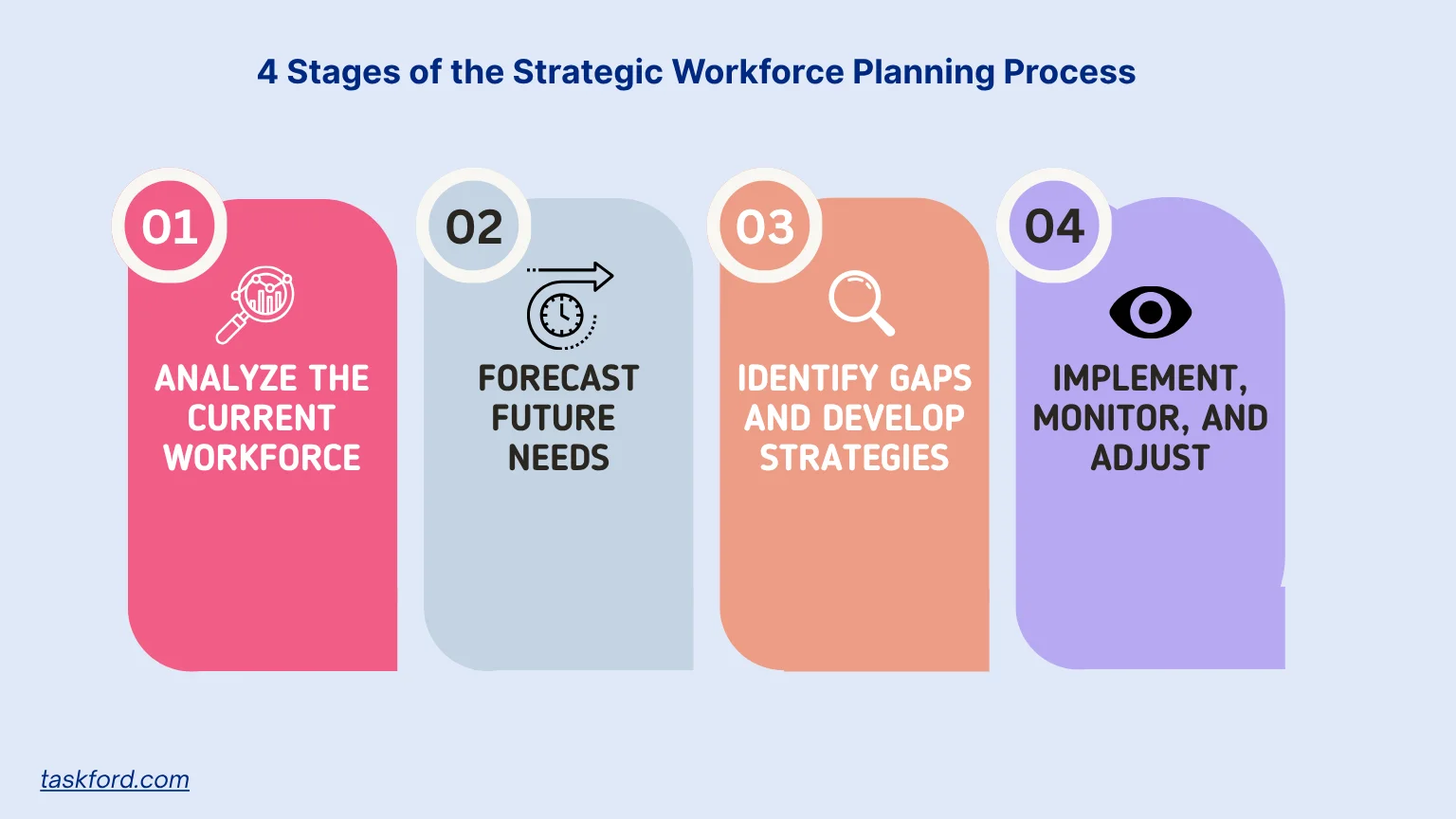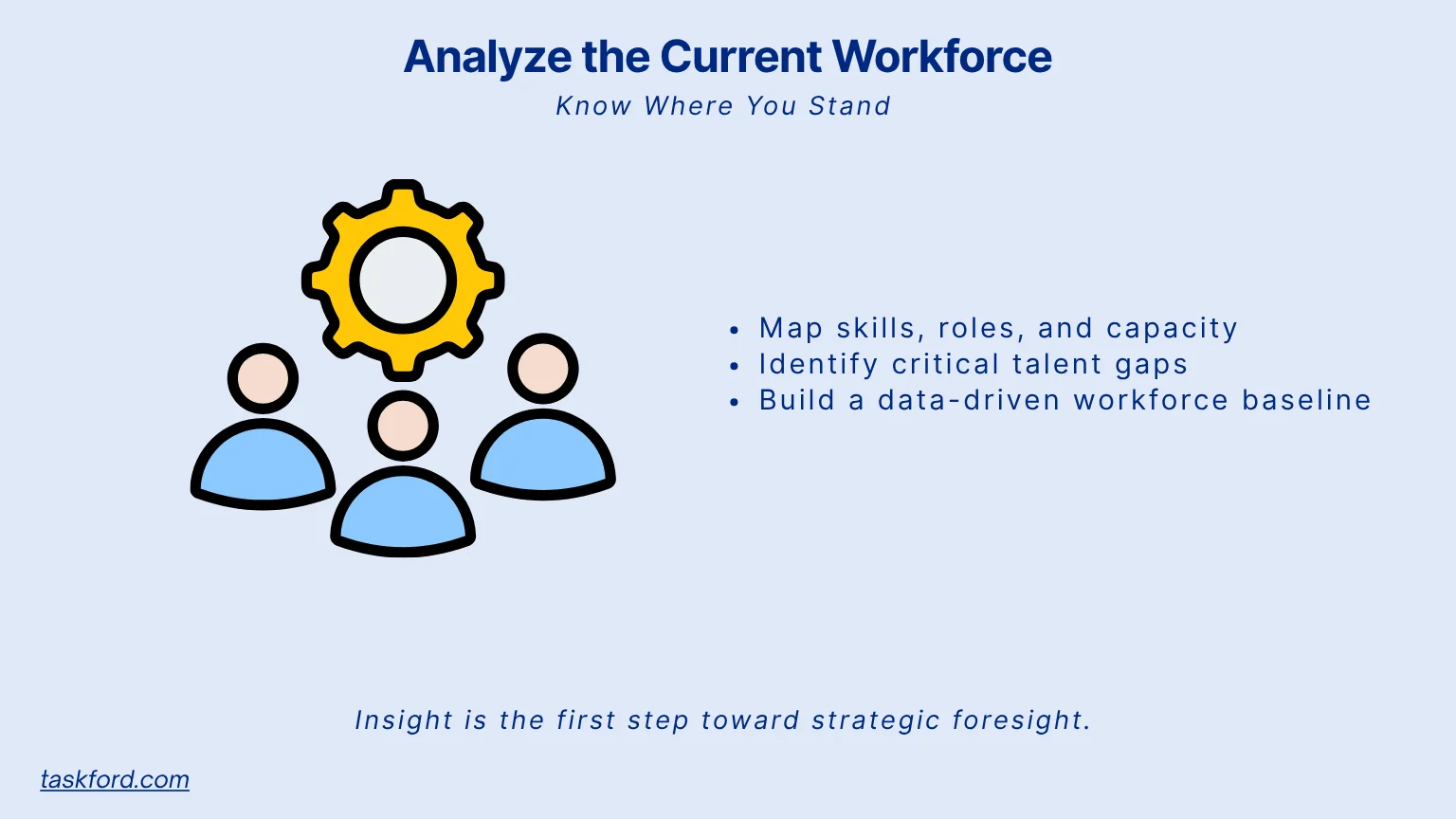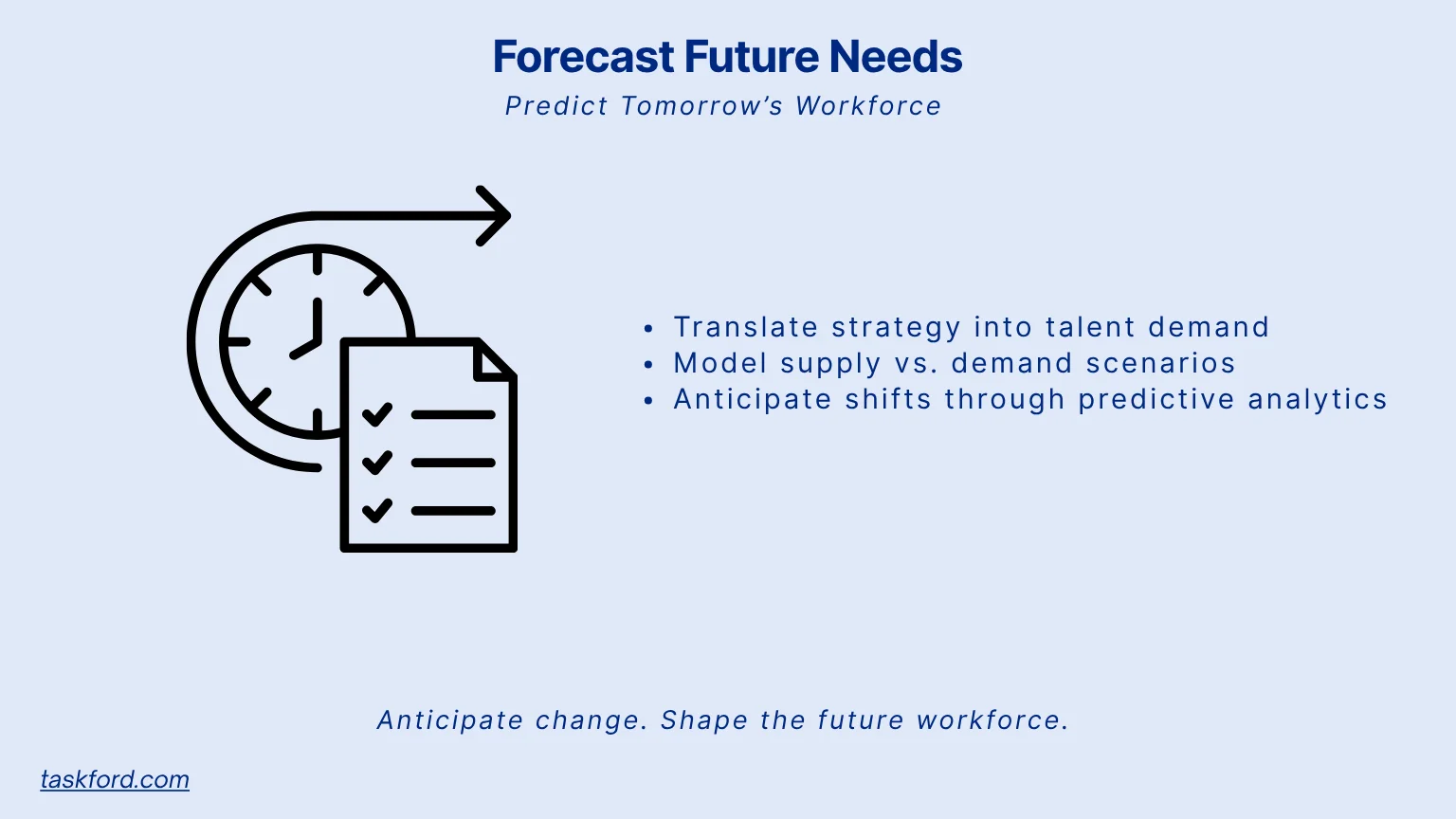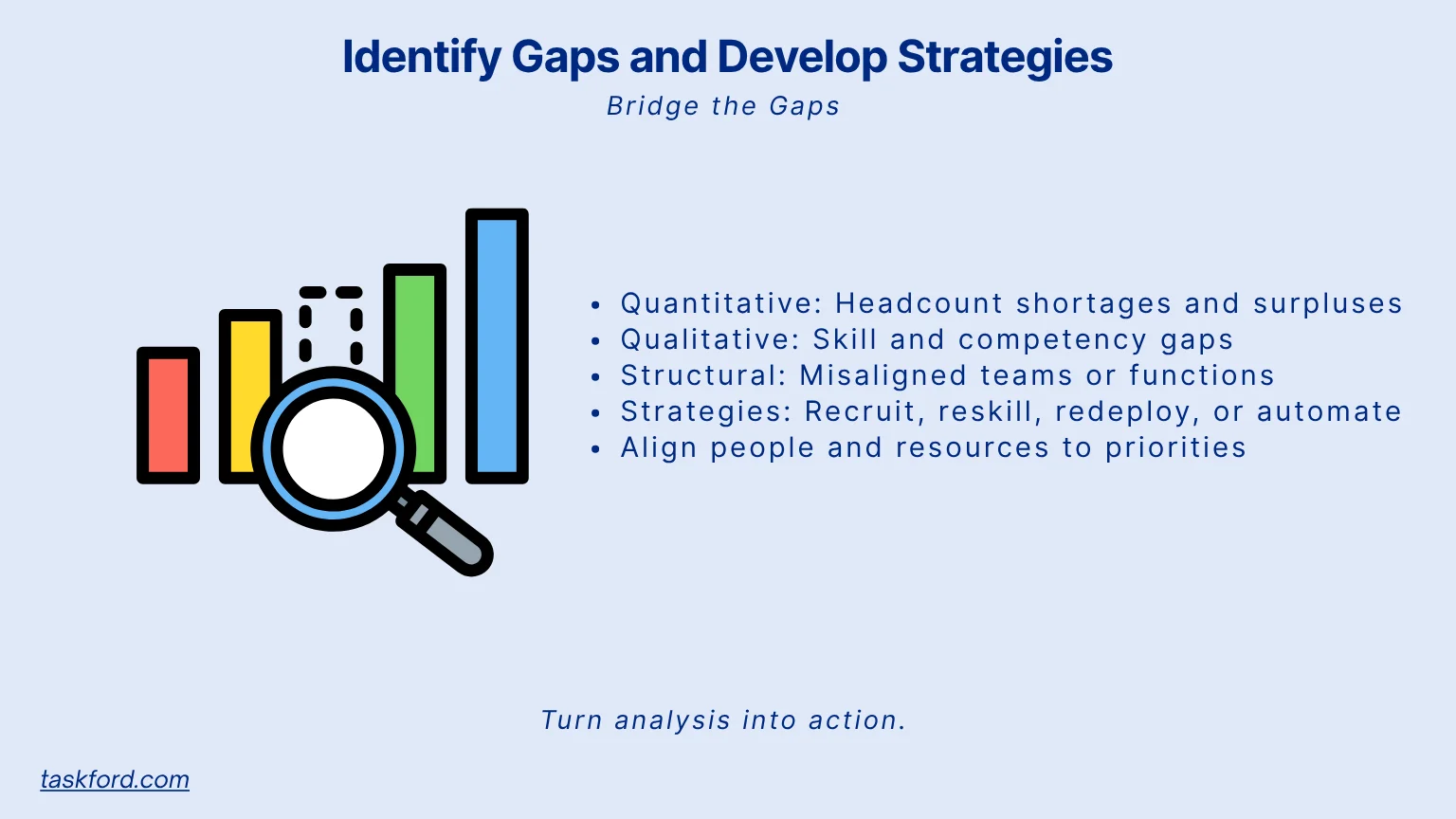4 Stages of the Strategic Workforce Planning Process
Explore the four stages of the strategic workforce planning process and how they connect business strategy with future talent needs, enhancing resource planning
The workforce landscape is shifting faster than ever. Automation, artificial intelligence, hybrid work, and global skill shortages are redefining how organizations operate. In this environment, businesses can no longer rely on reactive hiring or short-term staffing fixes. They need a long-term approach to ensure the right talent is available when and where it is needed.
That approach is strategic workforce planning. It provides a forward-looking framework that aligns people, skills, and capacity with business strategy. Done correctly, it becomes a key driver of agility and competitiveness. This article breaks down the four stages of the strategic workforce planning process, explains why it matters now, and explores the challenges and future trends shaping the field.
What Is Strategic Workforce Planning?
Strategic workforce planning (SWP) is the systematic process of ensuring that an organization has the right people, with the right skills, in the right roles, at the right time.
It connects workforce capabilities directly to long-term business strategy and helps leaders anticipate future talent needs before gaps appear.
Difference from Operational Workforce Planning
- Operational planning focuses on day-to-day staffing, schedules, and filling immediate vacancies.
- Strategic planning looks further ahead, identifying the capabilities the business will need to grow, innovate, and stay competitive.
Primary Goals
- Identify potential talent risks early.
- Anticipate emerging skill needs driven by technology or market change.
- Support evidence-based decisions about hiring, reskilling, and restructuring.
In essence, strategic workforce planning transforms workforce management from a reactive process into a strategic advantage.
Why Strategic Workforce Planning Matters Now
Strategic workforce planning is the process of analyzing, forecasting, and aligning workforce supply and demand with an organization’s long-term strategy. It identifies the capabilities needed to achieve business goals and ensures the right people are in the right roles at the right time.
This process goes beyond short-term hiring. It connects talent planning with corporate strategy, helping organizations manage capacity, control labor costs, and respond to market changes. Strategic workforce planning is closely linked to capacity planning and resource management, as all three deal with optimizing resources to meet demand efficiently.
- Capacity planning focuses on understanding how much output or performance an organization can deliver with its current resources.
- Resource management ensures those resources, including people, time, and budgets are allocated effectively across projects and departments.
- Strategic workforce planning bridges the two, ensuring human capital is managed with the same foresight and precision as any other key asset.
When executed well, workforce planning improves productivity, reduces skill gaps, and builds agility into the organization’s structure.
(Learn more: What is Capacity Planning)
The Four Stages of the Strategic Workforce Planning Process
Here are the 4 stages of strategic workforce planning process:

Stage 1: Analyze the Current Workforce

The first step in strategic workforce planning is to gain a clear picture of the current workforce. Organizations must understand the size, structure, and skills of their teams before predicting what they’ll need in the future.
Key Actions:
- Conduct a skills inventory across all functions to identify core and emerging capabilities.
- Map competencies and certifications relevant to strategic goals.
- Evaluate demographics, turnover trends, and succession risk.
- Measure productivity, resource utilization, and capacity levels using HR analytics.
Tools and Data Sources:
- HR information systems (HRIS)
- Payroll and project allocation data
- Performance management systems
- Visualization dashboards for data-driven insights
Outcome: A clear baseline of workforce strengths, weaknesses, and vulnerabilities. This forms the foundation for future planning and risk assessment.
Stage 2: Forecast Future Needs

Once you know where your workforce stands today, the next step is to determine what will be required tomorrow. Forecasting future workforce needs means translating business strategy into talent demand.
This requires input from multiple departments: leadership provides direction, HR brings workforce data, and finance offers budget constraints.
Demand Forecasting:
- Translate business plans such as expansion, new products, or digital transformation into workforce requirements.
- Use scenario modelling and quantitative forecasting to estimate demand for specific skills and roles.
- Consider market and industry trends that could influence workforce composition.
Supply Forecasting:
- Assess internal pipelines for promotion, retirement, and attrition.
- Evaluate external labor markets, regional skill availability, and competition for talent.
- Factor in automation, outsourcing, and remote work trends.
Advanced Considerations:
- Apply predictive analytics to model workforce supply and demand.
- Use AI-based simulations to forecast skill shifts over time.
- Include capacity planning metrics to determine how workload changes will affect staffing (Learn more: The Capacity Planning Metrics Every Team Should Track)
Outcome: A detailed gap analysis showing where projected workforce supply will fall short of demand, and what skills are at risk.
Stage 3: Identify Gaps and Develop Strategies

The third stage focuses on identifying gaps between the current workforce and the forecasted needs. This analysis reveals where there are shortages, surpluses, or misalignments in skills or headcount.
Gap analysis typically covers three dimensions:
- Quantitative gaps: Are there enough people to meet upcoming demand?
- Qualitative gaps: Do employees possess the right skills and competencies?
- Structural gaps: Is the workforce organized efficiently across departments or locations?
Once these gaps are identified, organizations can develop strategies to address them. Common approaches include:
- Recruitment and talent acquisition: Bringing in new skills or expanding headcount.
- Training and development: Upskilling or reskilling employees to meet future needs.
- Succession planning: Preparing high-potential employees for leadership roles.
- Redeployment: Moving employees from declining areas to growth functions.
- Outsourcing or automation: Managing repetitive or low-value tasks more efficiently.
This is where resource management plays a crucial role. Resource managers must align people with projects that best utilize their skills while keeping workloads balanced. By analyzing utilization rates, they can identify underused talent or areas of overcommitment.
The outcome of this stage is a strategic action plan that includes timelines, responsibilities, and measurable objectives for workforce transformation.
Stage 4: Implement, Monitor, and Adjust

The final stage is implementation. A workforce plan is only effective when put into action and monitored continuously to stay relevant.
Execution involves HR teams, line managers, and department heads collaborating to bring recruitment, training, and restructuring strategies to life.
Implementation:
- Roll out recruitment campaigns, learning programs, and technology adoption based on the action plan.
- Ensure cross-functional collaboration between HR, Finance, and Operations to synchronize execution.
Monitoring and Measurement:
- Track KPIs such as:
- Cost per hire
- Internal mobility rate
- Vacancy duration
- Capability maturity levels
- Employee engagement and retention metrics
- Use real-time analytics dashboards to visualize progress and identify bottlenecks.
Continuous Improvement:
- Conduct quarterly or annual reviews to test assumptions.
- Adjust forecasts as business priorities, technology, or markets evolve.
- Keep workforce planning dynamic, not static, so it remains relevant.
Outcome: A living, adaptive workforce plan that keeps people strategy aligned with long-term business objectives.
Challenges in Strategic Workforce Planning and How to Overcome Them
Despite its benefits, implementing strategic workforce planning comes with several challenges:
1. Data Fragmentation Across Systems
Challenge: Workforce data is often siloed across HR, finance, and operations, leading to incomplete insights. Solution: Integrate data through centralized analytics platforms or HR dashboards that consolidate multiple data sources. This provides a single source of truth for decision-making.
2. Limited Leadership Alignment
Challenge: Executives may not see workforce planning as a strategic priority. Solution: Connect workforce metrics to business outcomes such as revenue growth, project delivery, and productivity. Present workforce planning as a financial and operational tool, not just an HR activity.
3. Forecasting Uncertainty
Challenge: Market changes, economic volatility, and technology disruption make long-term forecasts difficult. Solution: Use scenario planning and rolling forecasts that are updated quarterly. This ensures plans stay relevant even when assumptions shift.
4. Change Resistance
Challenge: Managers and teams may be hesitant to adopt data-driven or future-oriented approaches. Solution: Build a culture of accountability by linking workforce planning outcomes to management KPIs. Provide training and incentives that encourage data-based decisions.
5. Skill Obsolescence
Challenge: Rapid technological change means existing skills can become outdated quickly. Solution: Develop continuous reskilling programs supported by learning platforms and skills matrix that identify emerging capabilities.
By addressing these challenges directly, organizations can make workforce planning both strategic and sustainable.
Future Trends in Strategic Workforce Planning
The future of workforce planning is increasingly data-driven and technology-enabled. Several key trends are reshaping how organizations approach it:
- AI and Predictive Analytics: Artificial intelligence enhances forecasting accuracy and provides scenario-based insights that help leaders anticipate workforce shifts.
- Skills-Based Planning: Organizations are moving from job-centric to skill-centric models, focusing on transferable capabilities rather than fixed roles.
- Integration of ESG and DEI Goals: Workforce planning is expanding to include sustainability and diversity metrics as part of long-term value creation.
- Hybrid and Borderless Workforces: Planning now includes remote and global talent pools, requiring new strategies for collaboration and compliance.
- Strategic Ecosystem Thinking: Businesses increasingly rely on freelancers, contractors, and digital labor platforms as part of a flexible talent ecosystem.
These trends demand closer integration between strategic workforce planning and resource management to ensure adaptability.
Best Practices for Effective Workforce Planning
High-performing organizations treat workforce planning as a continuous, data-driven discipline. The following best practices can elevate its effectiveness:
- Integrate Data Systems: Connect HR, finance, and operational data to enable consistent analysis and forecasting.
- Adopt Rolling Planning Cycles: Refresh workforce forecasts every quarter to maintain accuracy and responsiveness.
- Prioritize Scenario Planning: Model multiple “what-if” situations to test resilience under different business conditions.
- Build Leadership Accountability: Embed workforce objectives in performance metrics for executives and managers.
- Develop a Skills Intelligence Framework: Continuously track emerging skills and link them to learning and development initiatives.
- Leverage Predictive Analytics: Use data to anticipate turnover, skill shortages, and succession risks before they become urgent.
- Connect Workforce and Capacity Planning: Align human capital decisions with project and resource management processes for optimal efficiency.
These practices turn workforce planning into a dynamic capability that supports sustainable performance.
Conclusion
Strategic workforce planning is no longer just an HR function. It is a core component of business strategy that influences growth, innovation, and resilience. Organizations that master the four stages, including analysis, forecasting, action planning, and implementation, create a competitive edge by aligning people and business direction.
The future of workforce planning will rely heavily on analytics, adaptability, and integrated data systems. As work continues to evolve, the ability to plan strategically for talent will define which organizations thrive and which fall behind.
Learn more:
- 8 Resource Optimization Skills Your Teams Will Thank You For
- Top 8 Resource Planning Tools for Hybrid Teams in 2026: A Feature-by-Feature Comparison
- Resource Management Explained: Key Definition, Must-Know Terms & Proven Techniques
Subscribe for Expert Tips
Unlock expert insights and stay ahead with TaskFord. Sign up now to receive valuable tips, strategies, and updates directly in your inbox.